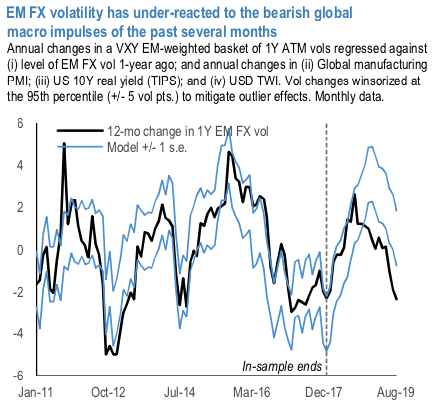EMFX volatility has under-reacted to the deterioration in global manufacturing and the attendant tightening in financial conditions YTD. Severe undervaluation of volatility has been a persistent feature of currency markets this year that has only recently begun to respond to the worsening in the global risk backdrop after the break of 7.0 on USDCNY in early August. This corrective process has a long runway in our view, in large part because we estimate that VXY Global has to climb 2.5 % pts. merely to eliminate its cyclical cheapness, let alone factoring in any additional risk premium under stress. As was the case in 2018, EM FX volatility may well lead this re-pricing because US dollar strength accompanying the ongoing slump in global growth has diametrically opposite effects on monetary conditions in advanced and emerging economies.
Unlike in DMs where USD strength / FX weakness loosens financial conditions – often in cahoots with easier monetary policy (c.f. RBA and RBNZ this year) – and helps alleviate domestic slowdowns, EMEs conversely experience a tightening of monetary and credit conditions due to increased debt-servicing pressures on corporates with foreign currency liabilities and foreign ownership of local currency bond markets that is prone to retrenchment.
It is a little surprising then that EM FX vols have under-reacted so severely to the bearish global impulses that have been in train all year.
The net outcome of the drop in Global PMI (vol +ve), USD TWI strength
(vol +ve) and fall in US real yields (vol -ve) should have been to push a VXY-EM weighted basket of 1Y ATM vols 0.5 %pts. higher y/y (-0.8 to +1.8 the +/- 1 s.e. range); the actual outturn has been a 2.3 vol pt. decline. The degree of this under-reaction looks even more severe if TRY is excluded from the EM basket on grounds that last year’s sell-off in the lira is too extreme a template to judge other EMs, since it further weakens any justification for mean- reversion lower in vol from 3Q’18’s elevated levels.
The cheapness of EM FX vol is especially pronounced in longer expiries (1Y) given the flatness of EM vol curves. The 1Y – 1M VXY EM vol curve is currently almost flat, which has typically not proved a sustainable state of affairs: either curves have to invert at higher vol levels amid FX stress, or markets drift into a pocket of calm that pulls the front-end lower and steepens term structures. We judge that the former is more likely in coming months, in part because of initial conditions on valuations as outlined earlier, and partly because long-end vols and vol curves have not priced in the accelerated de-coupling of US Treasury yields and the US dollar recently. While US rates and USD have been diverging all year, their moves have taken on urgency in August with the curve inversion-led cliff edge in 10Y yields (-40bp MTD) and an equally sharp coincidental surge in the greenback (JBDNUSD +1.8% MTD). USD vs. US rate de-correlation has long been recognized by options investors as bullish for vol. The intuition is that a lower UST yields lead to a mechanical widening of USD/EM (and indeed all USD/FX) forward points; longer the tenor, more pronounced this effect since forward points scale linearly in time-to-expiry. When accompanied by strength in spot USD FX, this exacerbates moves in forwards, and it is the volatility of the latter that underlies option pricing. The realized volatility differential between spot and 1Y forwards across USD/EM has climbed sharply of late and is approaching distress highs of 2016 and 2018, even as EM vol curves have flattened (refer above chart). Courtesy: JPM



 Global Markets React to Strong U.S. Jobs Data and Rising Yields
Global Markets React to Strong U.S. Jobs Data and Rising Yields  Wall Street Analysts Weigh in on Latest NFP Data
Wall Street Analysts Weigh in on Latest NFP Data  Gold Prices Fall Amid Rate Jitters; Copper Steady as China Stimulus Eyed
Gold Prices Fall Amid Rate Jitters; Copper Steady as China Stimulus Eyed  U.S. Banks Report Strong Q4 Profits Amid Investment Banking Surge
U.S. Banks Report Strong Q4 Profits Amid Investment Banking Surge  UBS Predicts Potential Fed Rate Cut Amid Strong US Economic Data
UBS Predicts Potential Fed Rate Cut Amid Strong US Economic Data  U.S. Stocks vs. Bonds: Are Diverging Valuations Signaling a Shift?
U.S. Stocks vs. Bonds: Are Diverging Valuations Signaling a Shift?  Urban studies: Doing research when every city is different
Urban studies: Doing research when every city is different  Energy Sector Outlook 2025: AI's Role and Market Dynamics
Energy Sector Outlook 2025: AI's Role and Market Dynamics  U.S. Treasury Yields Expected to Decline Amid Cooling Economic Pressures
U.S. Treasury Yields Expected to Decline Amid Cooling Economic Pressures  European Stocks Rally on Chinese Growth and Mining Merger Speculation
European Stocks Rally on Chinese Growth and Mining Merger Speculation  Oil Prices Dip Slightly Amid Focus on Russian Sanctions and U.S. Inflation Data
Oil Prices Dip Slightly Amid Focus on Russian Sanctions and U.S. Inflation Data  Fed May Resume Rate Hikes: BofA Analysts Outline Key Scenarios
Fed May Resume Rate Hikes: BofA Analysts Outline Key Scenarios  Gold Prices Slide as Rate Cut Prospects Diminish; Copper Gains on China Stimulus Hopes
Gold Prices Slide as Rate Cut Prospects Diminish; Copper Gains on China Stimulus Hopes  Stock Futures Dip as Investors Await Key Payrolls Data
Stock Futures Dip as Investors Await Key Payrolls Data  China’s Growth Faces Structural Challenges Amid Doubts Over Data
China’s Growth Faces Structural Challenges Amid Doubts Over Data  Moldova Criticizes Russia Amid Transdniestria Energy Crisis
Moldova Criticizes Russia Amid Transdniestria Energy Crisis  Geopolitical Shocks That Could Reshape Financial Markets in 2025
Geopolitical Shocks That Could Reshape Financial Markets in 2025 































